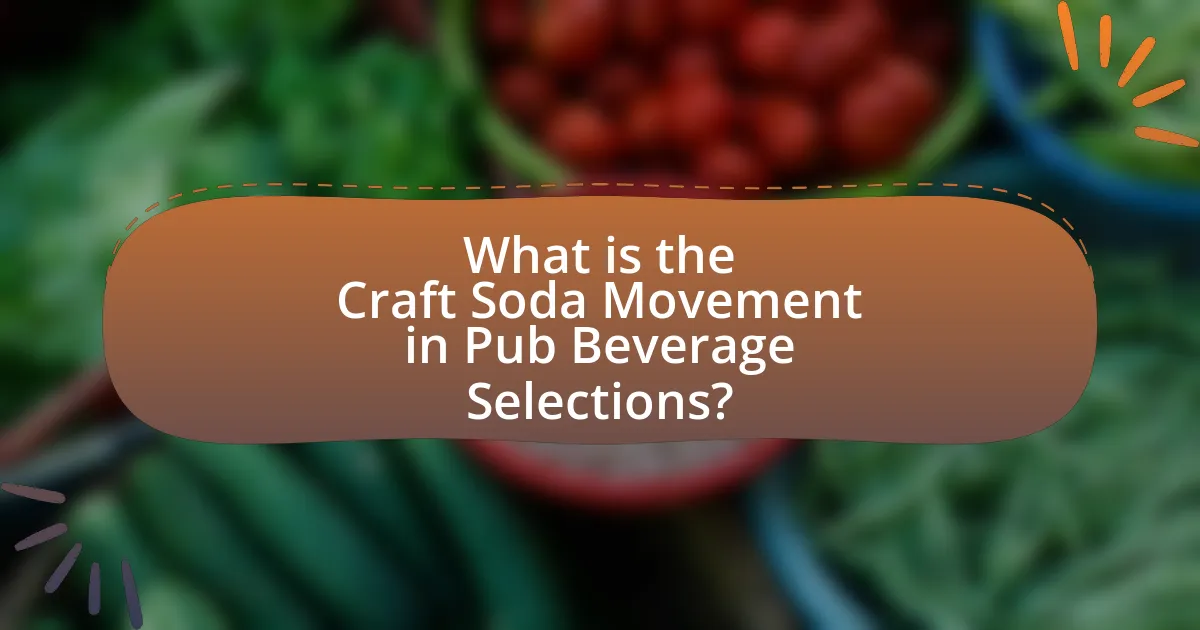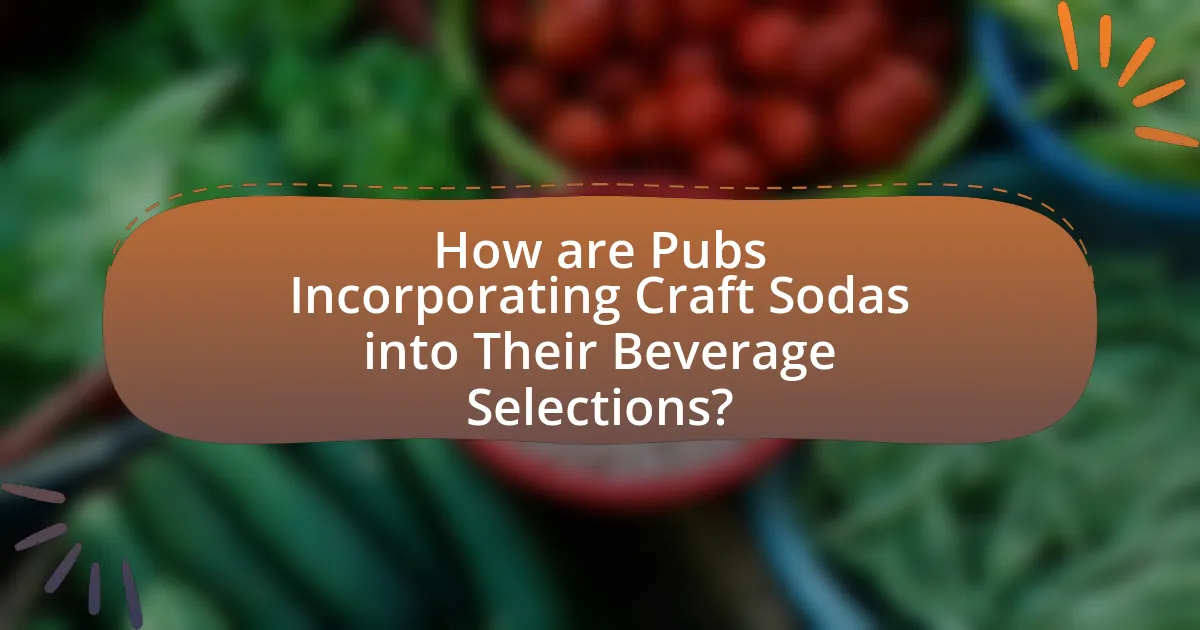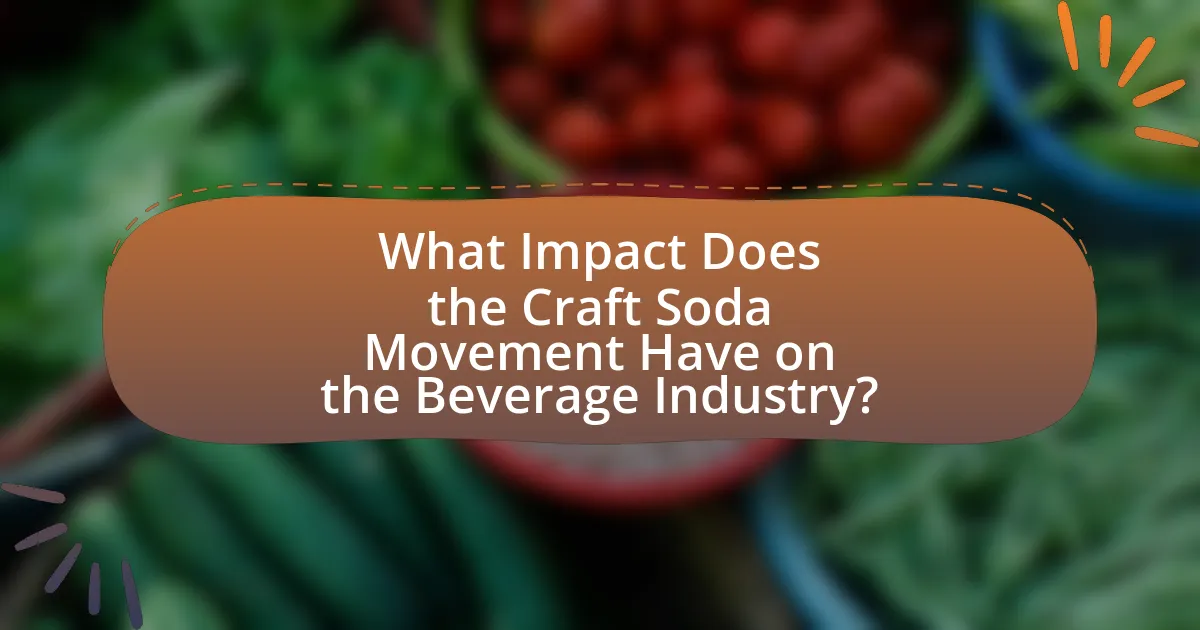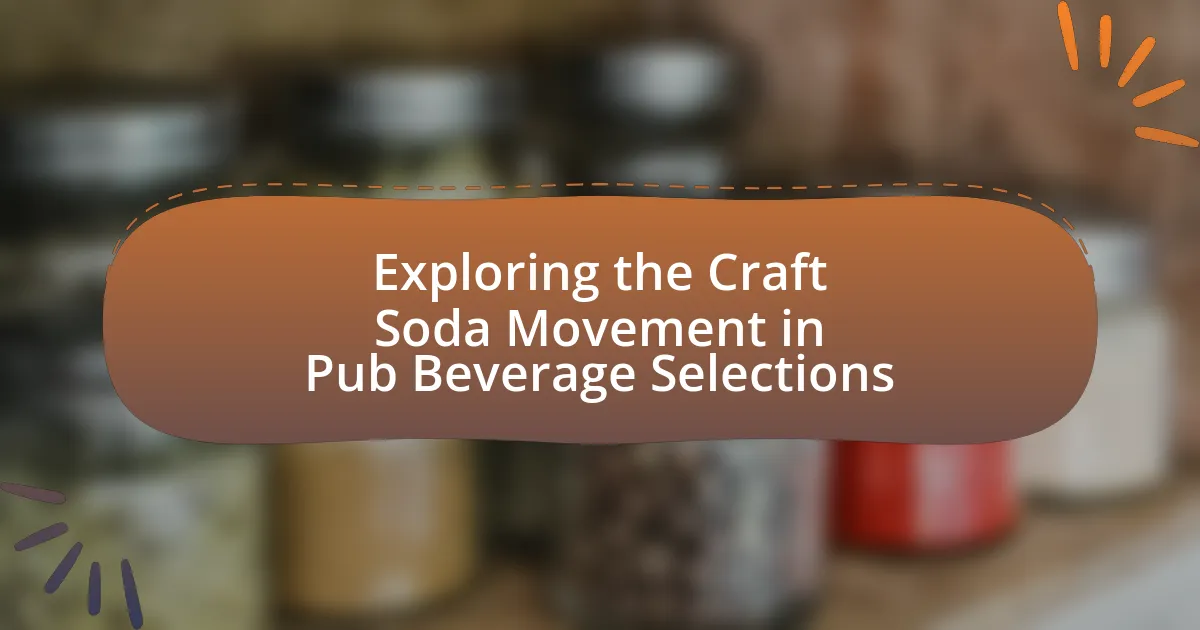The Craft Soda Movement in pub beverage selections represents a growing trend towards offering artisanal, small-batch sodas that prioritize unique flavors and high-quality ingredients. Originating in the early 2000s, this movement has gained traction as consumers, particularly millennials and Generation Z, seek healthier alternatives to traditional soft drinks. The article explores the cultural trends driving this movement, the differences between craft sodas and mass-produced options, and the ways pubs are incorporating these beverages into their menus. It also addresses the challenges pubs face in sourcing and stocking craft sodas, the impact of this movement on the beverage industry, and future prospects for craft sodas in pub settings.

What is the Craft Soda Movement in Pub Beverage Selections?
The Craft Soda Movement in pub beverage selections refers to the growing trend of offering artisanal, small-batch sodas that emphasize unique flavors and high-quality ingredients. This movement has emerged as consumers increasingly seek alternatives to traditional soft drinks, favoring beverages that are often made with natural sweeteners, organic ingredients, and innovative flavor combinations. The rise of craft soda brands, such as Fentimans and Boylan Bottling Co., highlights this shift, as they provide options that appeal to health-conscious and flavor-seeking patrons. The craft soda movement not only enhances the beverage selection in pubs but also aligns with the broader craft beverage trend, which values authenticity and local production.
How did the Craft Soda Movement originate?
The Craft Soda Movement originated in the early 2000s as a response to the growing consumer demand for artisanal and unique beverage options. This movement was characterized by small, independent producers creating sodas with natural ingredients, distinctive flavors, and a focus on quality, contrasting sharply with mass-produced soft drinks. The rise of the craft beer movement significantly influenced this trend, as consumers began seeking similar authenticity and creativity in non-alcoholic beverages. By 2015, the craft soda market had expanded significantly, with sales reaching approximately $1 billion, demonstrating the increasing popularity and acceptance of craft sodas among consumers.
What cultural trends contributed to the rise of craft soda?
The rise of craft soda is primarily attributed to the growing consumer demand for artisanal and locally sourced products. This trend reflects a broader cultural shift towards valuing authenticity, quality, and unique flavors in food and beverages. As consumers increasingly seek alternatives to mass-produced soft drinks, craft soda brands have emerged, offering innovative flavors and natural ingredients. For instance, the craft beverage market has seen a significant increase, with the craft soda segment growing by over 20% annually in recent years, indicating a strong preference for these products among consumers. This cultural movement is also influenced by the rise of the health-conscious consumer, who often prefers beverages with fewer artificial ingredients and added sugars.
How does craft soda differ from traditional soft drinks?
Craft soda differs from traditional soft drinks primarily in its production methods and ingredient quality. Craft sodas are typically made in smaller batches using natural ingredients, such as real fruit juices and spices, while traditional soft drinks often rely on artificial flavors, high fructose corn syrup, and preservatives. This distinction is supported by the growing trend of craft beverage producers who emphasize artisanal techniques and unique flavor profiles, catering to consumers seeking authentic and innovative beverage options.
Why is the Craft Soda Movement gaining popularity in pubs?
The Craft Soda Movement is gaining popularity in pubs due to a growing consumer demand for unique, artisanal beverages that offer distinct flavors and healthier alternatives to traditional soft drinks. This trend is supported by the increasing interest in craft beverages overall, with the craft soda market projected to grow significantly, reflecting a shift towards quality and authenticity in beverage choices. Additionally, craft sodas often use natural ingredients and innovative flavor combinations, appealing to health-conscious consumers and those seeking new taste experiences.
What demographic is driving the demand for craft sodas?
The demographic driving the demand for craft sodas primarily consists of millennials and Generation Z consumers. These age groups are increasingly seeking unique, artisanal beverage options that align with their preferences for quality and authenticity. According to a report by the Beverage Marketing Corporation, millennials are particularly influential in the craft beverage market, with 54% expressing a preference for craft products over mass-produced alternatives. This trend is further supported by the growing interest in health-conscious and natural ingredients, which resonates with younger consumers who prioritize wellness and sustainability in their purchasing decisions.
How do craft sodas enhance the pub experience?
Craft sodas enhance the pub experience by offering unique flavors and artisanal quality that appeal to a diverse clientele. These beverages provide non-alcoholic options that cater to health-conscious consumers and designated drivers, allowing them to enjoy the social atmosphere without alcohol. The craft soda movement emphasizes small-batch production and innovative ingredients, which can create a distinct and memorable drinking experience. For example, craft sodas often feature locally sourced ingredients and creative flavor combinations, such as lavender or hibiscus, which can elevate the overall beverage selection in a pub. This variety not only attracts a wider audience but also encourages patrons to explore new tastes, enhancing their overall enjoyment and engagement within the pub environment.
What are the key characteristics of craft sodas?
Craft sodas are characterized by their unique flavors, high-quality ingredients, and small-batch production. Unlike mass-produced sodas, craft sodas often utilize natural sweeteners, such as cane sugar or honey, and incorporate distinctive flavor profiles derived from herbs, spices, and fruits. This artisanal approach results in beverages that emphasize authenticity and creativity, appealing to consumers seeking alternatives to traditional soft drinks. The craft soda movement has gained traction as consumers increasingly prioritize quality and unique taste experiences in their beverage selections.
What ingredients are commonly used in craft sodas?
Craft sodas commonly use ingredients such as natural sweeteners, flavor extracts, carbonation, and citric acid. Natural sweeteners like cane sugar, honey, or agave syrup provide sweetness without artificial additives. Flavor extracts derived from fruits, herbs, and spices create unique taste profiles, distinguishing craft sodas from mass-produced options. Carbonation is essential for the fizzy texture, while citric acid enhances flavor and acts as a preservative. These ingredients contribute to the artisanal quality and diverse flavors that characterize craft sodas, appealing to consumers seeking alternatives to traditional soft drinks.
How do flavor profiles in craft sodas compare to mainstream options?
Flavor profiles in craft sodas are typically more diverse and innovative compared to mainstream options, which often rely on a limited range of flavors. Craft sodas frequently incorporate unique ingredients such as herbs, spices, and exotic fruits, resulting in complex taste experiences. For instance, while mainstream sodas like cola and lemon-lime focus on sweetness and carbonation, craft sodas may feature flavors like lavender, hibiscus, or even jalapeño, appealing to consumers seeking novel and artisanal beverages. This trend is supported by the growth of the craft beverage industry, which has seen a 20% increase in craft soda sales from 2019 to 2021, indicating a rising consumer preference for distinctive flavor profiles.

How are Pubs Incorporating Craft Sodas into Their Beverage Selections?
Pubs are incorporating craft sodas into their beverage selections by offering them as non-alcoholic alternatives to traditional drinks. This trend caters to the growing demand for unique, flavorful options that appeal to a diverse clientele, including those who prefer not to consume alcohol. Many establishments are sourcing craft sodas from local producers, enhancing their beverage menus with distinctive flavors such as hibiscus, ginger, and root beer, which align with the artisanal ethos of the craft beverage movement. This integration not only attracts a broader audience but also supports local businesses, reflecting a commitment to community engagement and quality.
What strategies are pubs using to feature craft sodas?
Pubs are increasingly featuring craft sodas by incorporating them into their beverage menus alongside traditional alcoholic options. This strategy includes offering a diverse range of unique flavors that appeal to both non-drinkers and those seeking alternatives to alcohol. Many pubs also create signature cocktails using craft sodas as mixers, enhancing the overall drinking experience. Additionally, some establishments host tasting events or collaborate with local craft soda producers to promote these beverages, thereby attracting a wider audience. This approach not only diversifies the menu but also supports local businesses, which can lead to increased customer loyalty and engagement.
How do pubs curate their craft soda offerings?
Pubs curate their craft soda offerings by selecting unique, locally produced beverages that align with their brand identity and customer preferences. This curation process often involves sourcing from small-scale producers who emphasize quality ingredients and innovative flavors, ensuring that the sodas complement the overall beverage menu. Additionally, pubs may conduct taste tests and gather customer feedback to refine their selections, ultimately aiming to provide a diverse range of options that appeal to both non-drinkers and those seeking alternatives to alcoholic beverages.
What role does local sourcing play in pub beverage selections?
Local sourcing significantly influences pub beverage selections by enhancing the authenticity and appeal of offerings. Pubs that prioritize local beverages often attract customers seeking unique, regional flavors that reflect the local culture and community. This practice not only supports local economies but also fosters relationships with nearby producers, ensuring fresher ingredients and innovative products. For instance, a study by the Brewers Association indicates that 75% of craft beer drinkers prefer local breweries, highlighting the consumer preference for locally sourced options. This trend is mirrored in craft sodas, where local sourcing contributes to distinctive taste profiles and brand loyalty among patrons.
What challenges do pubs face when adding craft sodas?
Pubs face several challenges when adding craft sodas, primarily related to sourcing, consumer demand, and pricing. Sourcing craft sodas can be difficult due to limited availability from local producers, which may lead to inconsistent supply. Additionally, consumer demand for craft sodas may not be as high as for traditional alcoholic beverages, making it risky for pubs to invest in a new product line. Pricing is another challenge, as craft sodas often come at a higher cost than mass-produced options, which can deter price-sensitive customers. These factors collectively complicate the decision-making process for pubs considering the integration of craft sodas into their beverage offerings.
How do cost considerations impact craft soda selections?
Cost considerations significantly influence craft soda selections by determining the affordability and accessibility of these beverages for consumers and retailers. Higher production costs associated with craft sodas, due to premium ingredients and small-batch manufacturing, often lead to elevated retail prices. This pricing can limit consumer choices, as budget-conscious individuals may opt for cheaper alternatives. Additionally, establishments may prioritize cost-effective options to maintain profit margins, thereby affecting the variety of craft sodas available on their menus. According to a 2022 market analysis by Beverage Marketing Corporation, craft soda prices can be 20-30% higher than mainstream brands, which directly impacts consumer purchasing behavior and retailer stocking decisions.
What are the logistical challenges of stocking craft sodas?
The logistical challenges of stocking craft sodas include limited shelf life, varying demand, and distribution complexities. Craft sodas often have shorter shelf lives compared to mass-produced beverages, necessitating careful inventory management to minimize waste. Additionally, demand for specific flavors can fluctuate significantly, making it difficult for retailers to predict stock needs accurately. Distribution can also be challenging due to the smaller scale of craft soda producers, which may lead to inconsistent supply and increased shipping costs. These factors collectively complicate the stocking process for establishments aiming to offer a diverse selection of craft sodas.

What Impact Does the Craft Soda Movement Have on the Beverage Industry?
The craft soda movement significantly impacts the beverage industry by driving innovation and diversification in product offerings. This movement has led to an increase in small, independent producers creating unique flavors and using high-quality, natural ingredients, which contrasts with traditional mass-produced sodas. According to a report by the Beverage Marketing Corporation, the craft soda segment has seen a growth rate of approximately 20% annually, reflecting consumer demand for artisanal and healthier beverage options. This shift not only enhances consumer choice but also encourages larger beverage companies to adapt their strategies, leading to a broader range of products that cater to changing consumer preferences.
How is the craft soda movement influencing consumer preferences?
The craft soda movement is significantly influencing consumer preferences by promoting unique flavors and artisanal production methods. This shift is evident as consumers increasingly seek out beverages that offer distinct taste experiences, moving away from mass-produced options. According to a report by the Beverage Marketing Corporation, craft soda sales have grown by 20% annually, indicating a rising demand for innovative and high-quality soft drinks. Additionally, the emphasis on natural ingredients and local sourcing in craft sodas aligns with consumer trends favoring health-conscious and sustainable choices, further solidifying their appeal in the beverage market.
What trends are emerging as a result of the craft soda movement?
The craft soda movement is leading to several emerging trends, including a focus on unique flavors, natural ingredients, and artisanal production methods. Consumers are increasingly seeking out craft sodas that offer innovative flavor combinations, such as lavender lemon or spicy ginger, which differentiate them from traditional soft drinks. Additionally, there is a growing preference for beverages made with organic and locally sourced ingredients, reflecting a broader trend towards health-conscious and sustainable consumption. The rise of small-batch production is also notable, as many craft soda brands emphasize their artisanal approach, often highlighting their handmade processes and small-scale operations. This shift is supported by market data indicating that the craft beverage sector, including craft sodas, has seen significant growth, with sales increasing by over 20% in recent years, showcasing consumer demand for these distinctive products.
How are traditional beverage companies responding to the craft soda trend?
Traditional beverage companies are responding to the craft soda trend by diversifying their product lines to include craft-style sodas. This shift is evident as major brands like Coca-Cola and PepsiCo have introduced new craft soda offerings, often emphasizing unique flavors and artisanal production methods. For instance, Coca-Cola launched its “Craft Soda” line, which features small-batch recipes and natural ingredients, aiming to capture the growing consumer interest in authentic and premium beverage experiences. This strategic adaptation reflects a broader industry trend where traditional companies recognize the increasing demand for craft beverages, which have seen a significant rise in popularity, with the craft soda market projected to grow at a compound annual growth rate of 5.5% from 2021 to 2028.
What are the future prospects for craft sodas in pubs?
The future prospects for craft sodas in pubs are promising, driven by increasing consumer demand for unique and artisanal beverage options. As health-conscious consumers seek alternatives to traditional sugary sodas and alcoholic drinks, craft sodas offer a flavorful, lower-calorie option that aligns with these preferences. According to a report by Grand View Research, the global craft soda market is expected to grow significantly, with a projected CAGR of 9.5% from 2021 to 2028, indicating a robust trend towards craft beverages. This growth is further supported by the rise of local breweries and beverage artisans who are innovating with unique flavors and ingredients, making craft sodas an attractive addition to pub menus.
How might the craft soda movement evolve in the coming years?
The craft soda movement is likely to evolve by increasing its focus on unique flavors and health-conscious ingredients. As consumer preferences shift towards natural and artisanal products, craft soda brands are expected to innovate with exotic ingredients, lower sugar content, and functional benefits, such as probiotics or adaptogens. According to a report by Grand View Research, the global craft soda market is projected to grow significantly, driven by rising demand for non-alcoholic beverages and a growing interest in premium, small-batch products. This trend indicates that craft soda will not only diversify its flavor profiles but also position itself as a healthier alternative in the beverage market.
What innovations can we expect in craft soda production?
Innovations in craft soda production will likely include the use of natural and locally sourced ingredients, advanced fermentation techniques, and unique flavor combinations. Craft soda producers are increasingly focusing on health-conscious options, such as low-sugar or sugar-free alternatives, utilizing natural sweeteners like stevia or monk fruit. Additionally, the incorporation of probiotics for gut health is becoming more prevalent, as seen in brands that emphasize functional beverages. The trend towards sustainability is also influencing production methods, with many craft soda makers adopting eco-friendly packaging and practices. These innovations reflect a growing consumer demand for quality, health, and environmental responsibility in beverage choices.
What tips can pubs follow to successfully integrate craft sodas?
Pubs can successfully integrate craft sodas by curating a diverse selection that complements their existing beverage offerings. This involves sourcing high-quality craft sodas from local or reputable producers, which enhances the pub’s appeal to customers seeking unique flavors. Additionally, staff training on the characteristics and flavor profiles of the craft sodas ensures informed recommendations, improving customer experience.
Promoting craft sodas through creative marketing strategies, such as pairing them with specific food items or featuring them in seasonal menus, can attract attention and drive sales. According to a report by the Brewers Association, the craft beverage market has seen significant growth, indicating a rising consumer interest in artisanal products, including craft sodas. This trend supports the integration of craft sodas as a viable option for pubs looking to diversify their beverage selections.
How can pubs effectively market their craft soda selections?
Pubs can effectively market their craft soda selections by highlighting unique flavors and local sourcing. By showcasing the distinct taste profiles and ingredients of their craft sodas, pubs can attract customers seeking new beverage experiences. For instance, promoting limited-edition flavors or collaborations with local artisans can create a sense of exclusivity and community engagement. Additionally, utilizing social media platforms to share visually appealing images and customer testimonials can enhance visibility and interest. According to a 2021 survey by the Brewers Association, 60% of consumers are more likely to try a beverage if they see it promoted on social media, reinforcing the importance of digital marketing strategies in reaching potential customers.
What best practices should pubs consider for customer engagement with craft sodas?
Pubs should prioritize offering a diverse selection of craft sodas to enhance customer engagement. By featuring unique flavors and local brands, establishments can attract a wider audience and cater to varying tastes. Additionally, hosting tasting events or pairing craft sodas with food can create interactive experiences that encourage customer participation. Research indicates that 60% of consumers are interested in trying new beverage options, highlighting the importance of variety in driving engagement. Furthermore, utilizing social media to promote craft soda offerings and gather customer feedback can foster a sense of community and loyalty among patrons.
